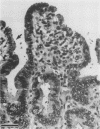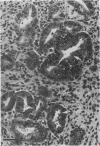Abstract
Cryptosporidial infections were established in five young foals with severe combined immunodeficiency following oral administration of 10(8) Cryptosporidium parvum oocysts. All foals shed oocysts (average of 8 x 10(6) to 2 x 10(8)/g of feces) until death. Inflammation and C. parvum organisms were observed in the common bile duct, duodenum, jejunum, and ileum. Since foals with severe combined immunodeficiency lack functional T and B lymphocytes and are incapable of antigen-specific immune responses, they are well suited for evaluating the pathogenesis and treatment of persistent cryptosporidiosis.
Full text
PDF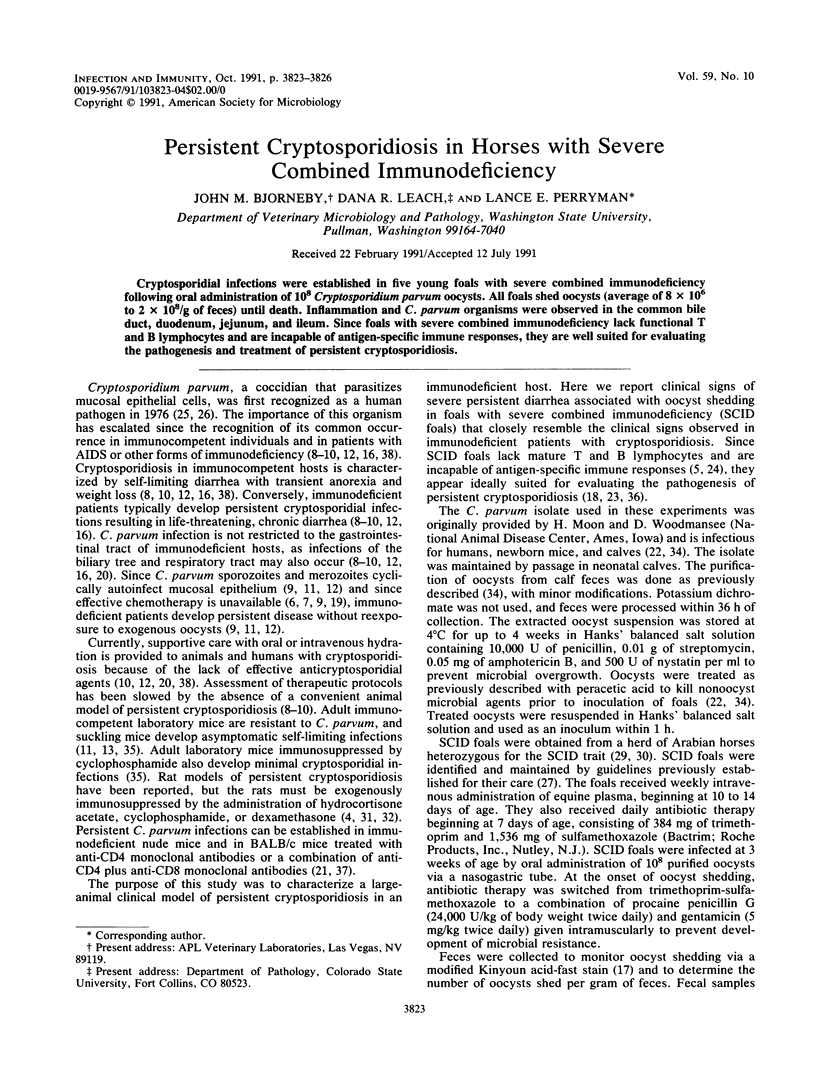
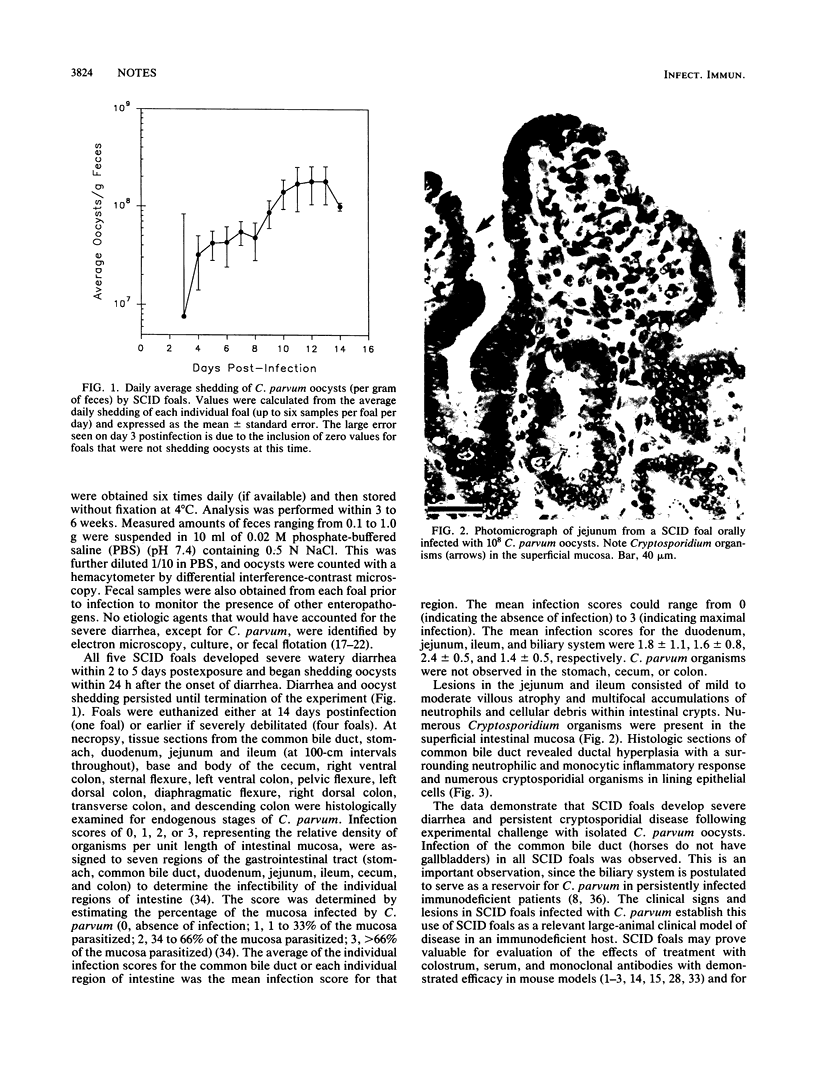
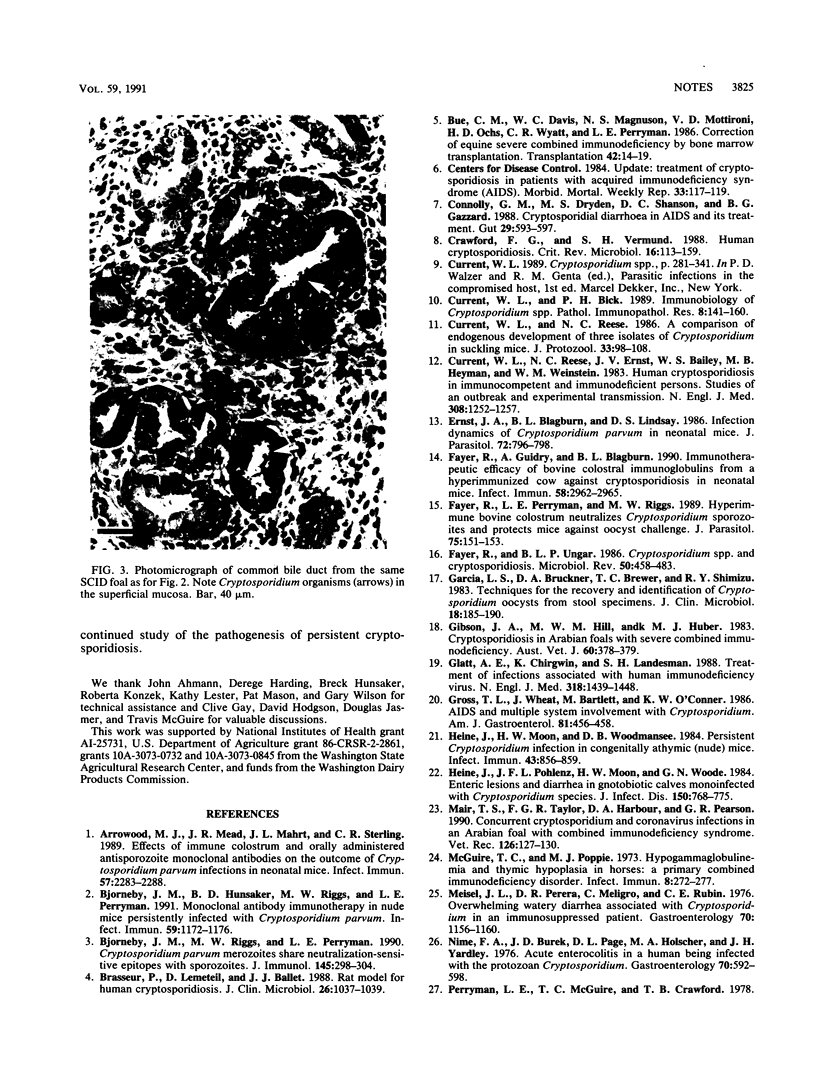
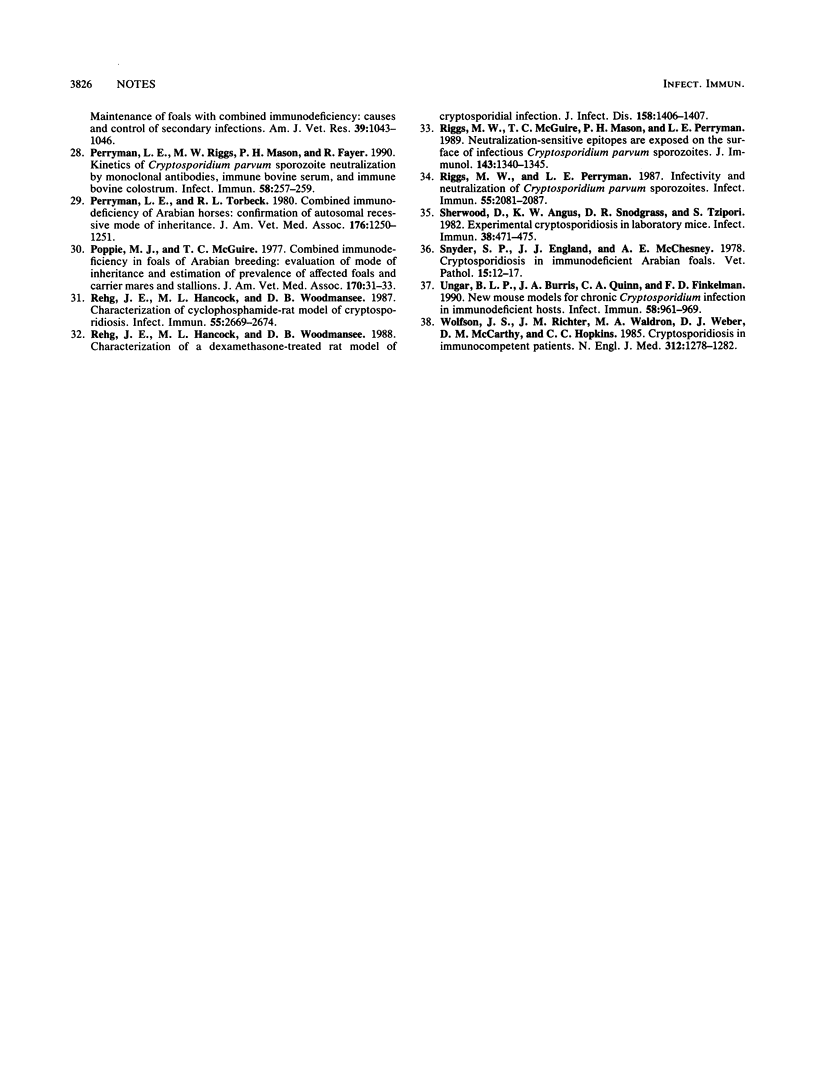
Images in this article
Selected References
These references are in PubMed. This may not be the complete list of references from this article.
- Arrowood M. J., Mead J. R., Mahrt J. L., Sterling C. R. Effects of immune colostrum and orally administered antisporozoite monoclonal antibodies on the outcome of Cryptosporidium parvum infections in neonatal mice. Infect Immun. 1989 Aug;57(8):2283–2288. doi: 10.1128/iai.57.8.2283-2288.1989. [DOI] [PMC free article] [PubMed] [Google Scholar]
- Bjorneby J. M., Hunsaker B. D., Riggs M. W., Perryman L. E. Monoclonal antibody immunotherapy in nude mice persistently infected with Cryptosporidium parvum. Infect Immun. 1991 Mar;59(3):1172–1176. doi: 10.1128/iai.59.3.1172-1176.1991. [DOI] [PMC free article] [PubMed] [Google Scholar]
- Bjorneby J. M., Riggs M. W., Perryman L. E. Cryptosporidium parvum merozoites share neutralization-sensitive epitopes with sporozoites. J Immunol. 1990 Jul 1;145(1):298–304. [PubMed] [Google Scholar]
- Brasseur P., Lemeteil D., Ballet J. J. Rat model for human cryptosporidiosis. J Clin Microbiol. 1988 May;26(5):1037–1039. doi: 10.1128/jcm.26.5.1037-1039.1988. [DOI] [PMC free article] [PubMed] [Google Scholar]
- Bue C. M., Davis W. C., Magnuson N. S., Mottironi V. D., Ochs H. D., Wyatt C. R., Perryman L. E. Correction of equine severe combined immunodeficiency by bone marrow transplantation. Transplantation. 1986 Jul;42(1):14–19. doi: 10.1097/00007890-198607000-00003. [DOI] [PubMed] [Google Scholar]
- Connolly G. M., Dryden M. S., Shanson D. C., Gazzard B. G. Cryptosporidial diarrhoea in AIDS and its treatment. Gut. 1988 May;29(5):593–597. doi: 10.1136/gut.29.5.593. [DOI] [PMC free article] [PubMed] [Google Scholar]
- Crawford F. G., Vermund S. H. Human cryptosporidiosis. Crit Rev Microbiol. 1988;16(2):113–159. doi: 10.3109/10408418809104469. [DOI] [PubMed] [Google Scholar]
- Current W. L., Bick P. H. Immunobiology of Cryptosporidium spp. Pathol Immunopathol Res. 1989;8(3-4):141–160. doi: 10.1159/000157146. [DOI] [PubMed] [Google Scholar]
- Current W. L., Reese N. C. A comparison of endogenous development of three isolates of Cryptosporidium in suckling mice. J Protozool. 1986 Feb;33(1):98–108. doi: 10.1111/j.1550-7408.1986.tb05567.x. [DOI] [PubMed] [Google Scholar]
- Current W. L., Reese N. C., Ernst J. V., Bailey W. S., Heyman M. B., Weinstein W. M. Human cryptosporidiosis in immunocompetent and immunodeficient persons. Studies of an outbreak and experimental transmission. N Engl J Med. 1983 May 26;308(21):1252–1257. doi: 10.1056/NEJM198305263082102. [DOI] [PubMed] [Google Scholar]
- Ernest J. A., Blagburn B. L., Lindsay D. S., Current W. L. Infection dynamics of Cryptosporidium parvum (Apicomplexa: Cryptosporiidae) in neonatal mice (Mus musculus). J Parasitol. 1986 Oct;72(5):796–798. [PubMed] [Google Scholar]
- Fayer R., Guidry A., Blagburn B. L. Immunotherapeutic efficacy of bovine colostral immunoglobulins from a hyperimmunized cow against cryptosporidiosis in neonatal mice. Infect Immun. 1990 Sep;58(9):2962–2965. doi: 10.1128/iai.58.9.2962-2965.1990. [DOI] [PMC free article] [PubMed] [Google Scholar]
- Fayer R., Perryman L. E., Riggs M. W. Hyperimmune bovine colostrum neutralizes Cryptosporidium sporozoites and protects mice against oocyst challenge. J Parasitol. 1989 Feb;75(1):151–153. [PubMed] [Google Scholar]
- Fayer R., Ungar B. L. Cryptosporidium spp. and cryptosporidiosis. Microbiol Rev. 1986 Dec;50(4):458–483. doi: 10.1128/mr.50.4.458-483.1986. [DOI] [PMC free article] [PubMed] [Google Scholar]
- Garcia L. S., Bruckner D. A., Brewer T. C., Shimizu R. Y. Techniques for the recovery and identification of Cryptosporidium oocysts from stool specimens. J Clin Microbiol. 1983 Jul;18(1):185–190. doi: 10.1128/jcm.18.1.185-190.1983. [DOI] [PMC free article] [PubMed] [Google Scholar]
- Gibson J. A., Hill M. W., Huber M. J. Cryptosporidiosis in Arabian foals with severe combined immunodeficiency. Aust Vet J. 1983 Dec;60(12):378–379. doi: 10.1111/j.1751-0813.1983.tb02853.x. [DOI] [PubMed] [Google Scholar]
- Glatt A. E., Chirgwin K., Landesman S. H. Current concepts. Treatment of infections associated with human immunodeficiency virus. N Engl J Med. 1988 Jun 2;318(22):1439–1448. doi: 10.1056/NEJM198806023182206. [DOI] [PubMed] [Google Scholar]
- Gross T. L., Wheat J., Bartlett M., O'Connor K. W. AIDS and multiple system involvement with cryptosporidium. Am J Gastroenterol. 1986 Jun;81(6):456–458. [PubMed] [Google Scholar]
- Heine J., Moon H. W., Woodmansee D. B. Persistent Cryptosporidium infection in congenitally athymic (nude) mice. Infect Immun. 1984 Mar;43(3):856–859. doi: 10.1128/iai.43.3.856-859.1984. [DOI] [PMC free article] [PubMed] [Google Scholar]
- Heine J., Pohlenz J. F., Moon H. W., Woode G. N. Enteric lesions and diarrhea in gnotobiotic calves monoinfected with Cryptosporidium species. J Infect Dis. 1984 Nov;150(5):768–775. doi: 10.1093/infdis/150.5.768. [DOI] [PMC free article] [PubMed] [Google Scholar]
- Mair T. S., Taylor F. G., Harbour D. A., Pearson G. R. Concurrent cryptosporidium and coronavirus infections in an Arabian foal with combined immunodeficiency syndrome. Vet Rec. 1990 Feb 10;126(6):127–130. [PubMed] [Google Scholar]
- McGuire T. C., Poppie M. J. Hypogammaglobulinemia and thymic hypoplasia in horses: a primary combined immunodeficiency disorder. Infect Immun. 1973 Aug;8(2):272–277. doi: 10.1128/iai.8.2.272-277.1973. [DOI] [PMC free article] [PubMed] [Google Scholar]
- Meisel J. L., Perera D. R., Meligro C., Rubin C. E. Overwhelming watery diarrhea associated with a cryptosporidium in an immunosuppressed patient. Gastroenterology. 1976 Jun;70(6):1156–1160. [PubMed] [Google Scholar]
- Nime F. A., Burek J. D., Page D. L., Holscher M. A., Yardley J. H. Acute enterocolitis in a human being infected with the protozoan Cryptosporidium. Gastroenterology. 1976 Apr;70(4):592–598. [PubMed] [Google Scholar]
- Perryman L. E., Riggs M. W., Mason P. H., Fayer R. Kinetics of Cryptosporidium parvum sporozoite neutralization by monoclonal antibodies, immune bovine serum, and immune bovine colostrum. Infect Immun. 1990 Jan;58(1):257–259. doi: 10.1128/iai.58.1.257-259.1990. [DOI] [PMC free article] [PubMed] [Google Scholar]
- Perryman L. E., Torbeck R. L. Combined immunodeficiency of Arabian horses: confirmation of autosomal recessive mode of inheritance. J Am Vet Med Assoc. 1980 Jun 1;176(11):1250–1251. [PubMed] [Google Scholar]
- Poppie M. J., McGuire T. C. Combined immunodeficiency in foals in Arabian breeding: evaluation of mode of inheritance and estimation of prevalence of affected foals and carrier mares and stallions. J Am Vet Med Assoc. 1977 Jan 1;170(1):31–33. [PubMed] [Google Scholar]
- Rehg J. E., Hancock M. L., Woodmansee D. B. Characterization of a dexamethasone-treated rat model of cryptosporidial infection. J Infect Dis. 1988 Dec;158(6):1406–1407. doi: 10.1093/infdis/158.6.1406. [DOI] [PubMed] [Google Scholar]
- Rehg J. E., Hancock M. L., Woodmansee D. B. Characterization of cyclophosphamide-rat model of cryptosporidiosis. Infect Immun. 1987 Nov;55(11):2669–2674. doi: 10.1128/iai.55.11.2669-2674.1987. [DOI] [PMC free article] [PubMed] [Google Scholar]
- Riggs M. W., McGuire T. C., Mason P. H., Perryman L. E. Neutralization-sensitive epitopes are exposed on the surface of infectious Cryptosporidium parvum sporozoites. J Immunol. 1989 Aug 15;143(4):1340–1345. [PubMed] [Google Scholar]
- Riggs M. W., Perryman L. E. Infectivity and neutralization of Cryptosporidium parvum sporozoites. Infect Immun. 1987 Sep;55(9):2081–2087. doi: 10.1128/iai.55.9.2081-2087.1987. [DOI] [PMC free article] [PubMed] [Google Scholar]
- Sherwood D., Angus K. W., Snodgrass D. R., Tzipori S. Experimental cryptosporidiosis in laboratory mice. Infect Immun. 1982 Nov;38(2):471–475. doi: 10.1128/iai.38.2.471-475.1982. [DOI] [PMC free article] [PubMed] [Google Scholar]
- Snyder S. P., England J. J., McChesney A. E. Cryptosporidiosis in immunodeficient Arabian foals. Vet Pathol. 1978 Jan;15(1):12–17. doi: 10.1177/030098587801500102. [DOI] [PubMed] [Google Scholar]
- Ungar B. L., Burris J. A., Quinn C. A., Finkelman F. D. New mouse models for chronic Cryptosporidium infection in immunodeficient hosts. Infect Immun. 1990 Apr;58(4):961–969. doi: 10.1128/iai.58.4.961-969.1990. [DOI] [PMC free article] [PubMed] [Google Scholar]
- Wolfson J. S., Richter J. M., Waldron M. A., Weber D. J., McCarthy D. M., Hopkins C. C. Cryptosporidiosis in immunocompetent patients. N Engl J Med. 1985 May 16;312(20):1278–1282. doi: 10.1056/NEJM198505163122002. [DOI] [PubMed] [Google Scholar]



